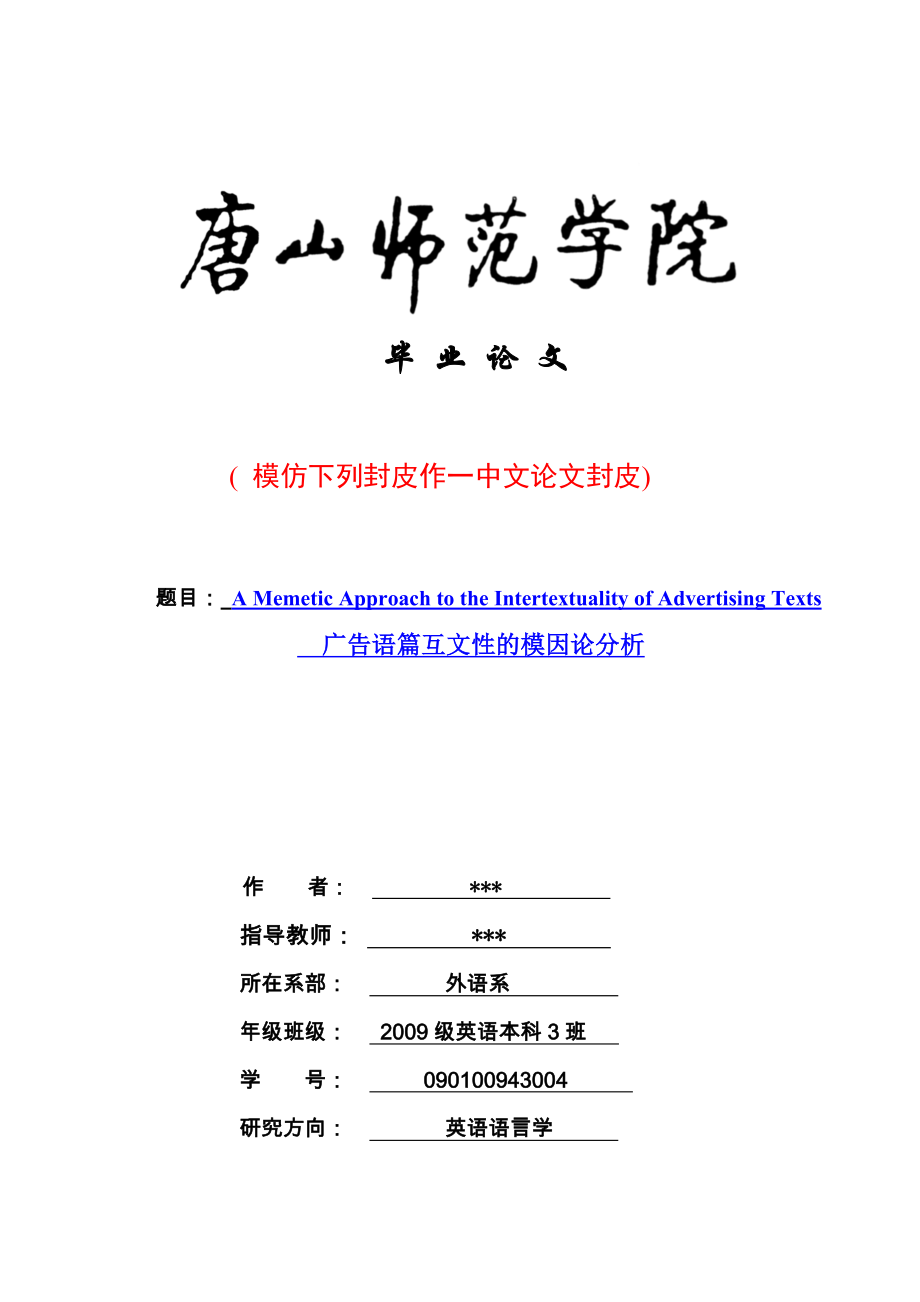 2013届毕 业 论 文英文开题报告书模版
2013届毕 业 论 文英文开题报告书模版



《2013届毕 业 论 文英文开题报告书模版》由会员分享,可在线阅读,更多相关《2013届毕 业 论 文英文开题报告书模版(6页珍藏版)》请在装配图网上搜索。
1、 毕 业 论 文 ( 模仿下列封皮作一中文论文封皮) 题目: A Memetic Approach to the Intertextuality of Advertising Texts 广告语篇互文性的模因论分析 作 者: * 指导教师: * 所在系部: 外语系 年级班级: 2009级英语本科3班 学 号: 090100943004 研究方向: 英语语言学 完成时间: 2012年12月 摘 要“互文性”这一概念最初是由法国符号学家于20世纪60年代末提出的,目前已成为当代文学理论和文化研究中使用频率最高的术语之一。“互文性”是语篇的基本特征,任何语篇都是由引语拼凑而成,任何语篇都是对其它语篇
2、的吸收和改造。互文性不仅存在于文学作品中,广告这种非文学文本同样具有互文现象。1976年,道金斯仿照基因首次提出模因这一概念,认为模因不仅是文化传承的单位,也是模仿的单位。这一理论使我们可以从模因传递的角度来分析互文性的产生。本论文将模因论用于分析广告中的互文现象,旨在进一步阐明互文性的形成源于模因的传递,以加深人们对广告语篇中模因的认识。本论文共分三章。第一章介绍了互文性的起源、定义和分类;第二章在模因论的基础上构建了系统的理论分析框架。第三章从模因论的角度分析了广告语篇中的互文现象,本章首先分析了广告的互文特性,接着分析了模因与互文的关系,本章最后根据互文性的不同表现形式将所收集的广告实例
3、分为引用、典故和仿拟三种类型,进而对这三种情况下模因的传播方式进行阐释。由此得出:模因和互文性之间存在着紧密的联系,正是由于模因的传播才形成了语篇之间的互文关系。关键词:互文性 模因 广告AbstractIntertextuality is a term coined by the French semiotician Julia Kristeva in the late 1960s. At present, intertextuality has become one of the most important terms of literary theory and cultural st
4、udies. Intertextuality is the basic feature of every text, for every text is made up of quotations and it is transformation of others. Intertextuality exists in literary works as well as in non-literary works, such as advertisements. Richard Dawkins proposes the term “meme” by imitating the word “ge
5、ne” in 1976. He holds that a meme is not only a unit of cultural transmission but also a unit of imitation. This theory enables us to analyze intertextuality from the view of meme spreading. This paper analyses the intertextuality phenomenon in advertisements from the memetic approach to further pro
6、ve that the spreading of memes results in intertextuality, which deepens our understanding of memes in advertisements. The thesis consists of three chapters. Chapter One gives a brief account of the definition and classification of intertextuality. Based on the memetics, Chapter Two constructs the t
7、heoretical framework for the study. Chapter Three analyzes intertextuality in advertisements from the memetic perspective. It starts with intertextual nature of advertisements and then presents the relationship between meme and intertextuality. At the end of the thesis, we classify the collected adv
8、ertising cases into citation, allusion and parody according to different forms of intertextuality, and then elaborate the spreading of meme in these three types. Then, we can draw the conclusion that there is a close relationship between meme and intertextuality which results from the spreading of m
9、eme.Key words: intertextuality meme advertisementOutlineThesis Statement: *(用一两句话写出中心论点)I. The Introduction of Intertextuality A.The origin and definition of intertextualityB.The classification of intertextuality 1. 2. a. b.II. Theoretical Basis of Analyzing the Intertextuality ofadvertisingMemetics
10、 A. The origin and definition of “meme” B. Three factors of being memesC. Types of Memes 1. Memetic genotype 2. Memetic phenotype D. A framework of analying the intertextuality of advertisingIII. A Memetic Approach to the Intertextuality in Advertising A. Intertextual nature of advertising B. Interr
11、elation between meme and intertextuality C. Memetic analysis of the intertextuality in advertising 1. Memetic analysis of citation 2. Memetic analysis of allusion 3. Memetic analysis of parodyConclusion.(用一两句话写出论文的结论) BibliographyAllen,G. 2000. Intertextuality. London and New York: RoutledgeBrown,G.
12、 Yule. 2000. Discourse Analysis. Beijing: Foreign Language Teaching and Research PressBlackmore. 2000. The Meme Machine. Oxford: Oxford University PressDawkins, R. 2006. The Selfish Gene. New York: Oxford University PressGee, J.P. 2000. An Introduction to Discourse Analysis: Theory and Method. Beiji
13、ng: Foreign Language Teaching and Research PressHatim,b&I.Mason. 2001. Discourse and the Translator. Shanghai: Shanghai Foreign Language PressJenny,L. 1982. The Strategy of Forms. Cambridge: Cambridge University PressKristeva,J. 1986. The Kristeva Reader. Oxford: Basic BlackwellXin Bin. 2000. Intert
14、extuality from a Critical Perspectine. Suzhou: Suzhou University Press陈琳霞,何自然. 2006.“语言模因探析”.外语教学与研究.第二期,108-114韩金龙.2005.“广告语篇互文性研究”. 四川外语学院学报.第一期,77-82何自然.2005.“语言中的模因”. 语言科学.第六期,54-64何自然,何雪林.2003.“模因论与社会语用”. 现代外语.第二期,201-209罗婷.2001.“论克里斯多娃的互文性理论”. 国外文学.第四期,9-14宋宏.2006 .广告英语阅读与欣赏.北京:国防工业出版社王海敏.2008
15、. “广告互文性研究”. 太原大学教育学院学报. 第六期,79-81吴钟明,邱进.2004.“互文性在广告翻译中的应用”.上海科技翻译.第二期,41-44 辛斌.2000. 语篇互文性的批评性研究.苏州:苏州大学出版社辛斌.2000 .“语篇互文性的语用分析”. 外语研究.第三期,12-13熊晓灿.2006.“广告语篇互文性的模因论分析”. 四川教育学院学报.第十一期,61-63 徐盛桓.2005.“幂姆于文学作品互文性研究”. 暨南大学华文学院学报.第一期,59-67赵静.1992.广告英语. 北京:外语教学与研究出版社张美玲.2007.“语言模因与语篇互文性的综合探析” .语文学刊.第一期,123-125
- 温馨提示:
1: 本站所有资源如无特殊说明,都需要本地电脑安装OFFICE2007和PDF阅读器。图纸软件为CAD,CAXA,PROE,UG,SolidWorks等.压缩文件请下载最新的WinRAR软件解压。
2: 本站的文档不包含任何第三方提供的附件图纸等,如果需要附件,请联系上传者。文件的所有权益归上传用户所有。
3.本站RAR压缩包中若带图纸,网页内容里面会有图纸预览,若没有图纸预览就没有图纸。
4. 未经权益所有人同意不得将文件中的内容挪作商业或盈利用途。
5. 装配图网仅提供信息存储空间,仅对用户上传内容的表现方式做保护处理,对用户上传分享的文档内容本身不做任何修改或编辑,并不能对任何下载内容负责。
6. 下载文件中如有侵权或不适当内容,请与我们联系,我们立即纠正。
7. 本站不保证下载资源的准确性、安全性和完整性, 同时也不承担用户因使用这些下载资源对自己和他人造成任何形式的伤害或损失。
